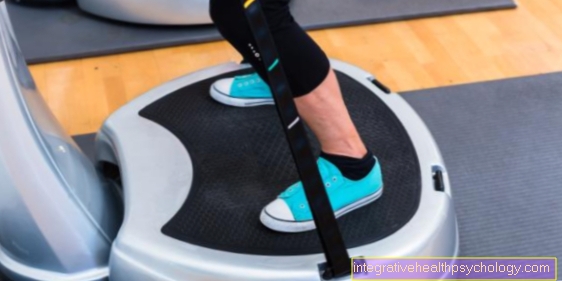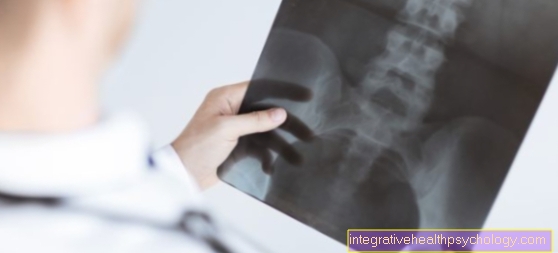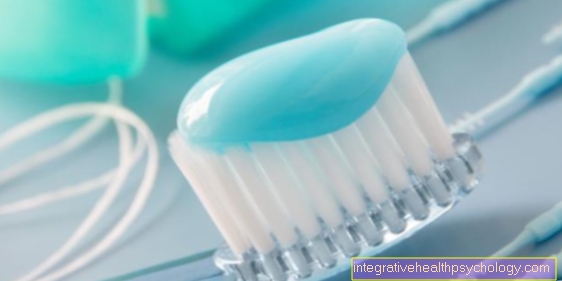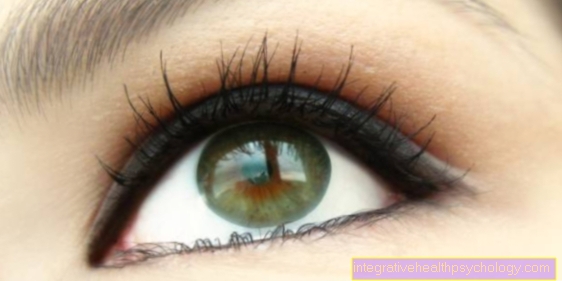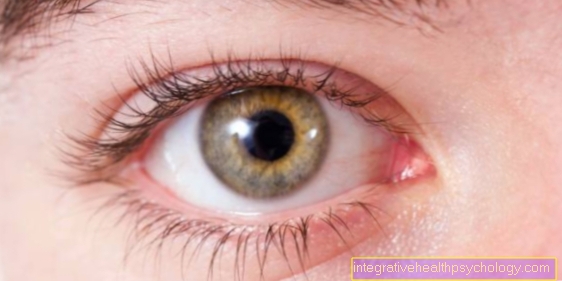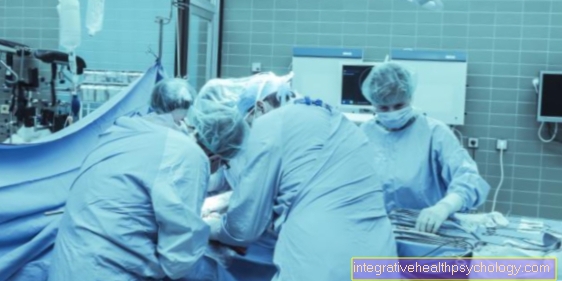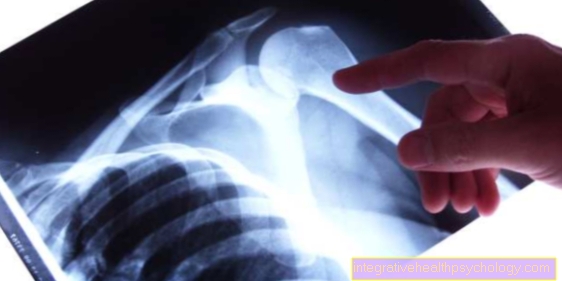Treatment of tailbone pain
introduction
Coccyx pain (coccygodynia) is pain that occurs in the lower spine area (Os coccygis) and usually has a stabbing or pulling character and can radiate into adjacent body regions.
Sometimes the patients complain of such severe pain that defecation, sexual intercourse or even just sitting seem almost impossible. About 80% of patients with tailbone pain are women.
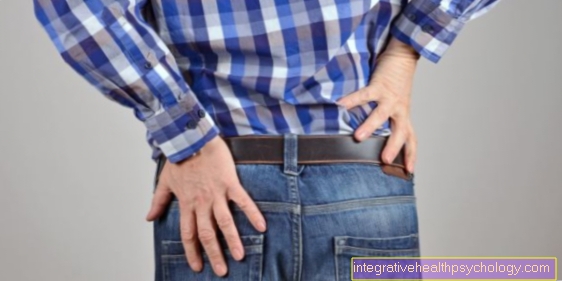
Treatment by cause
Mostly there is tailbone pain
- Periosteum inflammation on the coccyx
- Fractures
- Inflammation of the muscles, tendons or bones
- congenital coccyx malformations
- Coccyx fistulas, ulcers (tumors)
- Herniated disc of the lumbar spine
- severe mechanical stress (accidents, childbirth, pregnancy-related pressure of the child on the tailbone, chronic constipation)
or - psychosomatic illnesses
underlying.
Before adequate therapy can be carried out, adequate and targeted diagnostics are required in the form of a medical, clinical examination based on the index finger being inserted into the anus (digital - rectal examination) and in the form of X-rays (tailbone target image), MRI examinations of the coccyx , CT scans and a pelvic exam.
Treatment of tailbone pain
Tailbone pain is often a protracted one. First, the cause of the pain must be identified so that it can be treated. Is it a fraction (fracture) of the tailbone, pain reliever drugs such as paracetamol, ibuprofen or diclofenac (oral analgesics) are used first. There is also the possibility of infiltration of local anesthetics (local anesthetics) or anti-inflammatory drugs (glucocorticoids / cortisone).
Furthermore, the patient should keep a bed rest that promotes healing or use a trough-shaped seat ring to relieve the coccyx when sitting. Physiotherapy or psychotherapy can also help alleviate the symptoms. Studies show that alternative medical measures (complementary medicine) in the form of yoga, tai chi, meditation, osteopathy or acupuncture can also represent an adequate additional therapy option.
If these conservative measures do not improve the symptoms for more than 3 months, surgical removal (Resection) of bone parts (bone fragments) or the whole tailbone may be necessary. However, even an operation can lead to severe pain in the area of the scar and should therefore be carefully considered.
In the case of bruises in the area of the coccyx (e.g. from falls or direct violence), cooling or pain-relieving medication can improve the situation. However, after a bruise, the tailbone should be checked regularly. If there is excessive fluid retention in this area, surgical relief may be necessary.
Also with herniated discs of the lumbar spine (intervertebral disc prolapse of the lumbar spine) or intervertebral disc bulges of the lumbar spine (Lumbar disc protrusion) in the lumbar spine area, tailbone pain may occur. Often this pain is caused by nerve irritation of the sciatic nerve (nervus ischiadicus) or the nervus annococcygeus. First, attempts should be made to treat the herniated disc in a conservative way in the form of rest, massages, physiotherapy, warmth and exercise therapy, manual therapy or pain relieving medication. If the symptoms persist or if, in addition to the tailbone pain, severe neurological deficits occur or if an urgent need for action is known at an early stage, surgical therapy should be considered.
Which doctor treats tailbone pain?
Tailbone pain can often be treated by your family doctor. The therapy usually consists of physical rest and pain relievers if necessary. Your family doctor can prescribe this. Imaging may be needed to rule out serious injury to the tailbone, especially after trauma such as falls. To do this, the family doctor usually first sends the person affected to an orthopedic surgeon. This can arrange for the imaging to be performed by a radiologist. Since the coccyx is a bony structure, an X-ray is often sufficient; a CT or MRI is rarely required. If an orthopedic surgeon is involved in treating tailbone pain, he or she can also prescribe physiotherapy.
Seat ring
For tailbone pain, a seat ring is used to protect the tailbone while sitting. For this purpose, the seat ring is usually open at the back, so that the load is taken off the tailbone when sitting. This form of therapy is often chosen after traumatic tailbone pain. In this way, the tailbone can be spared temporarily while sitting is still possible. Seat wedges or soft seat cushions can also be used to treat tailbone pain. These are often very helpful for chronic tailbone pain. Not only can they be used in acute therapy, but also serve to prevent the tailbone pain from occurring again.
Which exercises can help?
Chronic tailbone pain is more common during pregnancy, especially at later stages of pregnancy. In the course of pregnancy, the ligaments and muscles loosen, and the more weight the child weighs, the more and more stress on the pelvic floor becomes. Over time, this can lead to back pain, particularly in the lower part of the back down to the tailbone. Exercises that strengthen the pelvic floor muscles help against this. Even without a pregnancy, the pelvic floor can loosen up and cause tailbone pain. It is not uncommon for the surrounding muscles to be the cause of the symptoms. These can be too weak, in this case not only strengthening the pelvic floor but also the gluteal muscles is a good starting point.
A well-trained physical therapist can best assess which form of exercise is helpful. This can help you learn certain exercises that you can then do alone at home. On the other hand, if the tension in the muscles in the buttocks is a problem, relaxation techniques are more likely to be necessary to alleviate the symptoms. Warm baths, massages and, if necessary, acupuncture can therefore often have an additional positive effect on the treatment of tailbone pain.
Read more on this topic at: Training the pelvic floor
Taping
Taping is especially useful for tailbone pain if the cause of the complaint is a muscular imbalance. The pelvic floor muscles are particularly affected, but they are difficult to treat with tape. However, if the cause of the pain lies in the gluteal muscles, tape can develop very good therapeutic powers. In particular, the elastic kinesio tape can be applied to the skin along the important muscles. It supports the pull of the weakened muscles and can counteract the pain.Occasionally the pain is caused by a pinched nerve. Here, too, by supporting the muscles, tape can free the nerve from its tightness and thus alleviate the symptoms.
Appointment with ?

I would be happy to advise you!
Who am I?
My name is dr. Nicolas Gumpert. I am a specialist in orthopedics and the founder of .
Various television programs and print media report regularly about my work. On HR television you can see me every 6 weeks live on "Hallo Hessen".
But now enough is indicated ;-)
In order to be able to treat successfully in orthopedics, a thorough examination, diagnosis and a medical history are required.
In our very economic world in particular, there is too little time to thoroughly grasp the complex diseases of orthopedics and thus initiate targeted treatment.
I don't want to join the ranks of "quick knife pullers".
The aim of any treatment is treatment without surgery.
Which therapy achieves the best results in the long term can only be determined after looking at all of the information (Examination, X-ray, ultrasound, MRI, etc.) be assessed.
You will find me:
- Lumedis - orthopedic surgeons
Kaiserstrasse 14
60311 Frankfurt am Main
You can make an appointment here.
Unfortunately, it is currently only possible to make an appointment with private health insurers. I hope for your understanding!
For more information about myself, see Lumedis - Orthopedists.
Further causes and treatment concepts
Inflammation of the muscles, tendons or bones in the area of the tailbone can also lead to severe tailbone pain. It is important to distinguish whether the inflammation is caused by a protracted (chronic) Process, such as chronic joint inflammation (arthritis) or acute or chronic inflammation e.g. of the bone (osteomyelitis). In the case of arthritis, which often occurs in the coccyx and is a rheumatological disease and thus a disorder of the immune system (psoriasis arthritis), local pain-relieving ointments (topical application), anti-inflammatory drugs (glucocorticoids / cortisone), and special immunosuppressants can be used Provide relief.
Inflammation of the bone (osteomyeltis) is usually caused by infections with bacteria, viruses or fungi. In approx. 75-80% the trigger is the bacterium Staphylococcus aureus. Therefore, in most cases it is necessary to start adequate antibiotic therapy and to clean / rinse the infected bone.
Tailbone pain can also develop in pregnant women during pregnancy or during childbirth. The coccyx pain caused by the child's pressure on the bony pelvis usually disappears on its own, but can also be treated with seat rings, physiotherapy or heat therapy. From the 2nd trimester onwards, it is also possible to use some pain relieving drugs.
Even during childbirth, pain often occurs due to irritation, compression or excessive stretching in the area of the coccyx. In the case of very severe tailbone pain caused by childbirth, anesthesia near the spinal cord (epidural anesthesia / PDA) can provide relief.
Another possibility of coccyx pain is the pilonidal sinus (pilonidal sinus / sacraldermoid / pilonidal cyst). This usually results in hair growing in in the area of the tailbone, but accidents or congenital malformations can also play a role. A connection (fistula) forms between the hair root and the deeper tissue. This connection provides a point of attack for intruders such as Bacteria represent. The treatment of the coccyx fistula can be started conservatively, so wait and see, but should be surgically in the case of severe pain or inflammation. As there is often a recurrence after surgery (Relapse) the fistula comes, in many cases a very well thought-out consideration is necessary.
In the case of tailbone pain caused by a tumor, the type of tumor must first be determined in order to be able to plan how to proceed. Coccyx tumors are often congenital malformation tumors in childhood (Teratoma, dermoid), but bone tumors, gynecological tumors or colonization (Metastases) other tumors are found. Depending on the type or size of the tumor or if other structures of the body have already been affected, various treatment options (surgery, chemotherapy, radiation) can be used to improve the symptoms of pain in the tailbone.
If no physical cause can be found, some patients may seek psychotherapy.
Medicines used to treat tailbone pain
Painkillers, which ideally have an anti-inflammatory (anti-inflammatory) effect, are particularly suitable for administering medication for acute tailbone pain.
These include, for example, the active ingredients diclofenac (Voltaren®), acetylsalicylic acid (Aspirin®) and ibuprofen.
Regular intake of these active ingredients without medical attention should be avoided, however, since the gastric mucosa is damaged in the long term by these drugs.
These remedies can also help with chronic pain in the rump area, but should primarily serve to ensure or further expand the freedom of movement. Because movement ultimately helps with back pain, regardless of the location, is still the best.
If the pain persists despite regular exercise, the family doctor can inject a local anesthetic if he considers it indicated. Like taking medication, this is used to completely eliminate the cause of the pain through exercise.
Is Warmth Or Cold Better For Treating Tailbone Pain?
Depending on the cause, the application of heat or cold may be indicated.
In both cases it is important not to injure the skin, i.e. to burn it or freeze it to death. Therefore, the area should be checked regularly when applying heat or cold. Also, always put a towel or something similar. between the temperature source and the skin.
Warmth helps with tension in general. So if the tailbone pain comes from poor posture and a lot of sitting, warmth can help here. This is more of a chronic pain that is only slightly noticeable when you are at rest and can get worse when you move. As a result, a relieving posture is often adopted, which continues to reduce the range of motion. To break this vicious circle, the application of heat can initially help.
Cold, on the other hand, should be used for falls on the tailbone, i.e. for bruises. The formation of a hematoma (bruise) can thus be reduced, as the blood vessels narrow locally due to the cold. Plus, it at least takes some of the pain out of the bruise.
Home remedies to treat tailbone pain
Above all, the best home remedy for chronic tailbone pain is still exercise, as lack of exercise is the most common cause of chronic back pain, regardless of its location.
Herbal pain relievers can help with acute tailbone pain, for example after a fall. These include arnica ointment, camphor, peppermint or pine needle oil and chilli, which are used externally by applying them to the appropriate area.
Camphor, peppermint and pine needle oil have a cooling effect and stimulate blood circulation and thus relieve pain. Chili, on the other hand, contains the “hot substance” capsaicin, which is also contained in some ointments. Capsaicin has a pain-relieving effect by permanently activating the pain receptors, which, however, tire quickly and then no longer pass on pain stimuli. Therefore, when it is applied, there is a short-term burning sensation on the skin, which should lead to a painless or painless phase immediately afterwards.

.jpg)



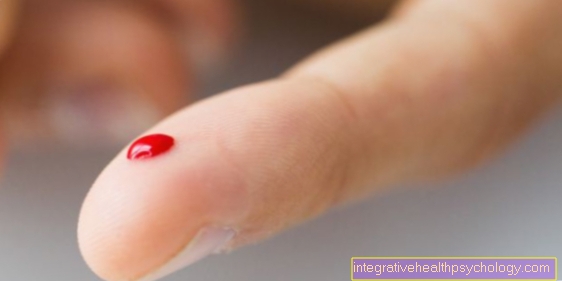







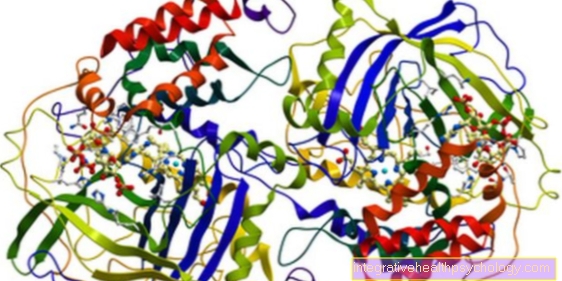
.jpg)


